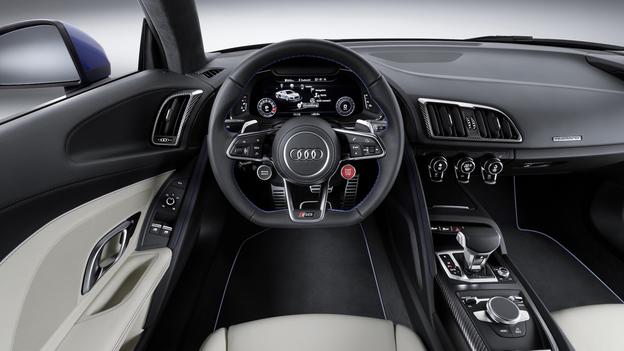Here it is, at long last. Audi’s second generation R8 Coupe, revealed online ahead of its proper, sweaty-palmed reveal at next week’s Geneva motor show.
And as expected, it’s a meticulous, thorough, well thought-out evolution of the original car that earned Audi so many spurs. It’s still four-wheel-drive, it’s still mid-engined and it still packs a punch, but everything has gotten lighter, stiffer and faster.
Just how fast is quite striking. Audi is currently only offering the new R8 with a 5.2-litre V10 engine in two guises – the “standard” 532bhp version and the range-topping V10 Plus with 602bhp. Yep, same as the Lamborghini Huracán.
Coupled to a lighter body weighing in at 1,454kg (3,205lbs) dry – 50kg lighter than the last R8 – and constantly variable four-wheel drive, the V10 Plus can accelerate from zero to 62mph in 3.2 seconds and top out at 205mph. Dr Ulrich Hackenberg, Audi’s board member for technical development, said: “The new R8 V10 Plus is the most powerful and fastest series production Audi of all time.” Yowser.
The standard V10 is no slouch, though (that’s the blue car above), posting times of 3.5 seconds to 62mph and a top speed of 200mph, while the new R8 E-tron – also being showcased at Geneva – will accelerate from zero to 62mph in 3.9 seconds and promises a range of more than 280 miles (more than double the range of the first R8 E-tron) thanks to better battery tech.
Back to the regular petrol cars, and both will feature the S-tronic double clutch gearbox, but with new software for faster shifting, together with a launch control and coasting function.
And in turn, this is allied to a four-wheel-drive system with an electro-hydraulic clutch on the front axle (replacing the visco clutch of the last car) and a mechanical diff on the rear axle. Audi tells us this newly developed Quattro system allows for fully variable torque distribution, meaning up to 100% of the car’s torque can be sent to either the front or rear axle.
It’s all wrapped up in Audi’s Space Frame body; the central tunnel, B-pillars and rear wall are all made from carbon fibre reinforced plastics (CFRP), while the front, roof arch and rear are made from cast aluminium. Not only is it lighter, but it’s 40% stiffer than before, too. Pointy.
There is double wishbone suspension all round, an aero-optimised underbody, electromechanical steering as standard – replacing the old hydraulic setup – and both cars will get passive dampers and steel suspension as standard. Though of course, you can option the adaptive magnetic dampers, with three modes (Auto, Comfort, Dynamic).
Inside, there’s now a fully digital “virtual cockpit” with all manner of variation for display, and many buttons on the steering wheel to control pretty much everything you need – including a button to make the exhausts chirrup that power even louder. This is a Good Button.
What else can we tell you? There are Audi’s new laser lights, a body that’s pretty much the same size as before (it’s bigger by about 1.6in), an evolutionary design, a fixed wing for the V10 Plus and all manner of customisation.
No word on UK prices just yet, but it’ll start from €165,000 for the base V10, and €187,400 for the V10 Plus. How does it feel and sound? Well, step this way, because TopGear.com was granted a hotride in a prototype. And it’s slidey.











